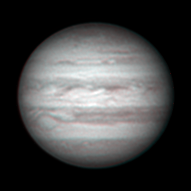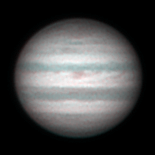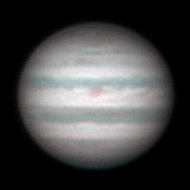Imaging Jupiter in ammonia absorption bands
Jupiter atmosphere is composed of many gases. Some absorb visual light and give colors to Jupiter cloud bands. Some, like methane have strong absorption bands in infrared visible for cameras. Imaging Jupiter with a bandpass filter covering one of such bands can give a clear view of distribution of given gas among various atmospheric features. Bright areas will have low concentration, wile dark - high. Methane band is often used to detect methane abundance. No other band at the moment is photographed on Jupiter. One reason is that most strong bands can be found in far infrared not accessible to normal cameras. Second may be the lack of filters and validations of given absorption bands actually showing what they should on bandpass photographs.
Ammonia is one of gases found on Jupiter. It's not very common, but it's there and there are some deep infrared images showcasing its distribution. In visible light there are two weak absorption bands that in theory may be used by amateurs. In this article I'll write about my test and results of imaging Jupiter in two ammonia absorption bands.
Bands and filters
One band is located around 540 nm, and second at 647 nm. The second one seems to be more popular in scientific publications (check vims.artov.rm.cnr.it for example). For both bands we can get bandpass filters. 540 nm is covered by Baader Solar Continuum, while for 647 there is a lot of industry filters as this is the wavelength of red lasers - thus look for laser line filters. There are even FWHM 1 nm filters for 647 nm, but for imaging 5-10 nm FWHM wide filters should be optimal. Such filters can be bought from Edmund Optics and other companies. On ebay there may be few too (but check if they aren't to wide cheaper filters). When buying one of those note their transmission (it may be low), diameter and thickness. 20-25 mm diameter or bit more can be mounted in Sky Watcher Moon filter plastic cells. Thick filters will be hard to lock within the cell (no counter ring). Baader Solar Continuum is easily available.
Imaging in ammonia band
The filters won't give a bright image. It won't be as dark as methane band, but still it's good to start with brighter f-ratio. I've used f/10 instead of usual f/20.
Image taken in one of the absorption bands will look quite similar to normal image. To showcase areas of ammonia concentration we have to compare it with a wider band where average sunlight reflection is domination the signal. For 540 nm a green RGB filter can be used and for 647 nm red filter. When you have images from both filters do a false color image (GCC or R,647,647). Reddish areas will show higher ammonia concentration. Greenish would be in places where ammonia band image would be brighter than average image in given color (low ammonia concentration but not necessarily as the comparison band may not be perfect, full of other absorption bands).
Results
I've managed to test 647 nm 10 nm FWHM bandpass filter from Edmund Optics. Compared with Baader LRGB Red filter the image looks like so:

With Solar Continuum filter the result is similar, although there is more greenish bands this time:


Greenish streak in SEB may be low on ammonia, but it also can be a false result from the comparison green band. If the band range used for comparison has other noticeable absorption bands then the comparison may be affected by them - if they somewhat overlap with ammonia band on some features. Dark areas in equatorial zone are reddish. They show deeper cloud layers which are rich in ammonia - so the result seems valid.
First results show that it's possible to get some result out of those two bands. To be sure we are actually imaging ammonia abundance more tests and validation is needed. The more people will try it the better.
Comment article